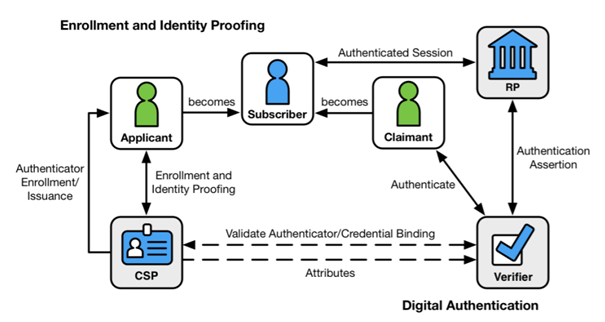SSI and Verifiable Credentials
SSI and Verifiable Credentials
How can Graphchain can be implemented for SSI (Self Sovereign Identity) and Verifiable Credentials? In order to understand this potential use case a definition of electronic indentity must be firstly presented.
What is an electronic identity?
According to an EU defition:
“An Electronic identity” is a means for people to prove electronically that they are who they say they are and thus gain access to services. The identity allows an entity (citizen, business, administration) to be distinguished from any other”.1
Self-sovereign identity (SSI) is an approach to digital identity that gives individuals control of their digital identities.2
According to this model, the (whole) identity of an entity (mainly focusing on a user) is actually distributed in different partial identities which are valid within different domains (contexts) of different enterprises (organizations).3
Figure: NIST Digital Identity Model, Source: NIST Special Publication 800-63 Volume 3 Revision 3, Digital Identity Guidelines

According to a concept of a Self Sovereign Identity by Christopher Allen.4
“the user must be central to the administration of identity. That requires not just the interoperability of a user’s identity across multiple locations, with the user’s consent, but also true user control of that digital identity, creating user autonomy. To accomplish this, a self-sovereign identity must be transportable; it can’t be locked down to one site or locale. A self-sovereign identity must also allow ordinary users to make claims, which could include personally identifying information or facts about personal capability or group membership. It can even contain information about the user that was asserted by other persons or groups.”
One of the potential business use cases for Graphchain is authentication of Digital Identities (DIDs) for legal persons (companies). This idea was firstly presented on the E-finance Lab and DZ Bank 2016 2016 Conference in Goethe University Frankfurt. (September 1st, 2016). “Using Blockchain for Digital Identifiers: Improving Data Security and Persistence for Digital Object Identifier (DOI) and Legal Entity Identifier (LEI)”. https://youtu.be/xlq_3U89gus
One of the challenges for digital identifiers is the decentralization and trust. Thanks to our cryptographic algorithm – “interwoven hash? our solution culd have been implemented in blockchain nodes with high level of trust.
In our flagship project Legal Entity Identifier – we have implemented verification of companies in Blockchain where the LEI company data stored in the semantic format can be verified against the network of Hyperledger Indy Blockchain.
In case of Self Sovereign Entity for humans – we see huge potential to cooperate in future with one of our project partners in Ontochain Open Call 1 – HIBI Human Blockchain Initiative represented by Datarella GmbH. HIBI can be defined as a kind of software development kit that provides block for Trustworthy, Formalized, Privacy-Preserving identity management in Blockchain. It is important to note that this solution is Blockchain agnostic and interoperable.
1. “Electronic Identities – a brief introduction”, page 3. https://ec.europa.eu/information_society/activities/ict_psp/documents/eid_introduction.pdf accessed on 5.11.2021.
2. https://en.wikipedia.org/wiki/Self-sovereign_identity accessed on 5.11.2021.
3. Md Sadek Ferdous, Farida Chowdhury, and Madini O. Alassafi ,”In search of Self-Sovereign Identity Leveraging Blockchain Technology”, Department of Computer Science and Engineering, Shahjalal University of Science and Technology, Sylhet 3114, Bangladesh, August 12, 2019, https://ieeexplore.ieee.org/stamp/stamp.jsp?tp=&arnumber=8776589 accessed on 5.11.2021.
4. Christopher Allen “The Path to Self-Sovereign Identity” April 25, 2016. http://www.lifewithalacrity.com/2016/04/the-path-to-self-soverereign-identity.html accessed: 6.11.2021.